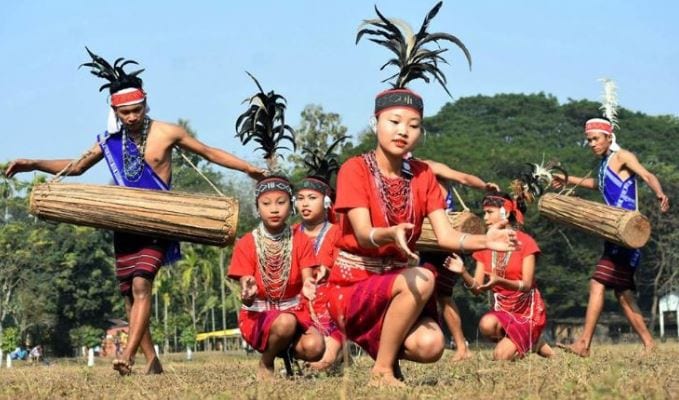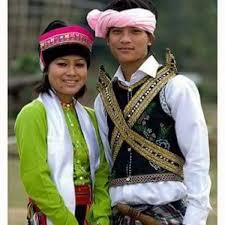
The Khasis
The traditional Khasi male dress is “Jymphong” or a longish sleeveless coat without collar, fastened by thongs in front. Now, the Khasis have adopted the western dress. On ceremonial occasions, they appear in “Jymphong” and dhoti with an ornamental waist-band. The Khasi traditional female dress is rather elaborate with several pieces of cloth, giving the body a cylindrical shape. On ceremonial occasions, they wear a crown of silver or gold on the head. A spike or peak is fixed to the back of the crown, corresponding to the feathers worn by the menfolk. The Khasis, the Jaintias and the Garos have a matrilineal society. Descent is traced through the mother, but the father plays an important role in the material and mental life of the family. While, writing on the Khasi and the Jaintia people, David Roy observed, ‘a man is the defender of the woman, but the woman is the keeper of his trust’. No better description of Meghalayan matrilineal society could perhaps be possible. In the Khasi society, the woman looks after home and hearth, the man finds the means to support the family, and the maternal uncle settles all social and religious matters. Earlier in the conservative Jaintia non-Christian families, however, the father only visits the family in the night and is not responsible for the maintenance of the family. Khasis follow a matrilineal system of inheritance. In the Khasi society, it is only the youngest daughter or “Ka Khadduh” who is eligible to inherit the ancestral property.
If ‘Ka Khadduh’ dies without any daughter surviving her, her next elder sister inherits the ancestral property, and after her, the youngest daughter of that sister. Failing all daughters and their female issues, the property goes back to the mother’s sister, mother’s sister’s daughter and so on. The Ka Khadduh’s property is actually the ancestral property and so if she wants to dispose it off, she must obtain consent and approval of the uncles and brothers. Among the War-Khasis, however property passes to the children, male or female, in equal shares but among the War-Jaintias, only the female children get the inheritance Marriage within a clan is a taboo. Rings or betel-nut bags are exchanged between the bride and the bridegroom to complete the union. In the Christian families, however, marriage is purely a civil contract. The Khasis are now mostly Christians. But before that, they believed in a Supreme Being, The Creator – U Blei Nongthaw and under Him, there were several deities of water and of mountains and also of other natural objects. Khasi women agreed with the fact that the girls in their community were more educated in comparison to the opposite gender. One of the major reasons being that the boys were required to help the family on the fields.

